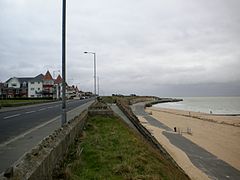Westbrook, Kent
| Westbrook | |
|---|---|
 Royal Esplanade |
|
| Westbrook shown within Kent | |
| Population | 4,126 (2011.Ward) |
| District | |
| Shire county | |
| Region | |
| Country | England |
| Sovereign state | United Kingdom |
| Post town | Margate |
| Postcode district | CT9 |
| Police | Kent |
| Fire | Kent |
| Ambulance | South East Coast |
| EU Parliament | South East England |
Westbrook is a Victorian seaside resort on the Thanet peninsula in the southeast corner of England. It is part of the ribbon development of the north Kent coast between Westgate-on-Sea to the west and Margate to the east.
Running through it is the main Canterbury Road where the Royal Sea Bathing hospital stands (now apartments). The row of shops opposite the hospital entrance includes Clarke and Crittenden. The Dog and Duck pub has been turned into offices for the Hospital Building site. Although a church still stands in the grounds it's not used.
At the 2001 UK census, the Westbrook electoral ward had a population of 4,319. The ethnicity was 97.8% white, 1% mixed race, 0.9% Asian, 0.3% black and 0% other. The place of birth of residents was 93.3% United Kingdom, 1.4% Republic of Ireland, 1.6% other Western European countries, and 3.7% elsewhere. Religion was recorded as 72.9% Christian, 0.2% Buddhist, 0.3% Hindu, 0% Sikh, 0.2% Jewish, and 0.3% Muslim. 12.9% were recorded as having no religion, 0.4% had an alternative religion and 12.8% did not state their religion.
The economic activity of residents aged 16–74 was 37.4% in full-time employment, 11.9% in part-time employment, 11.1% self-employed, 3.5% unemployed, 2.5% students with jobs, 3.4% students without jobs, 14.1% retired, 6% looking after home or family, 6.8% permanently sick or disabled and 3.5% economically inactive for other reasons. The industry of employment of residents was 16% retail, 11% manufacturing, 7.4% construction, 8.8% real estate, 21.6% health and social work, 8.9% education, 5.8% transport and communications, 5.3% public administration, 4.9% hotels and restaurants, 2.9% finance, 1.1% agriculture and 6.3% other. Compared with national figures, the ward had a relatively high proportion of workers in health and social work, and a relatively low proportion in agriculture, finance and real estate. Of the ward's residents aged 16–74, 16.7% had a higher education qualification or the equivalent, compared with 19.9% nationwide.
...
Wikipedia

